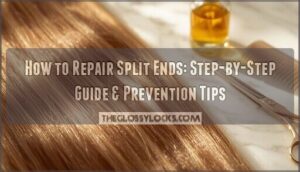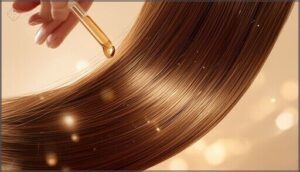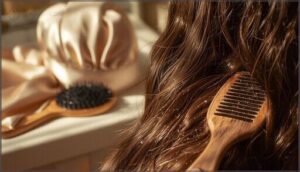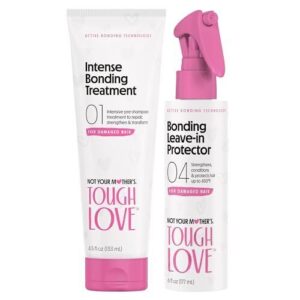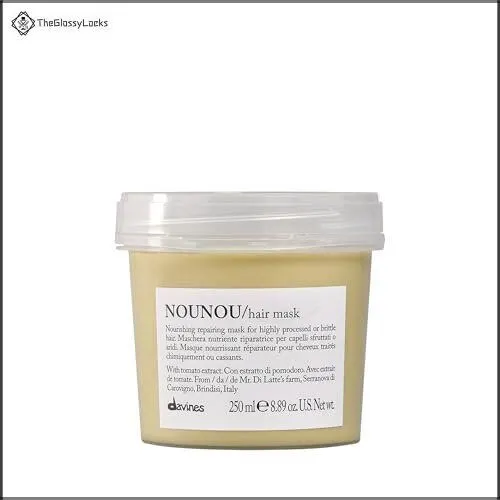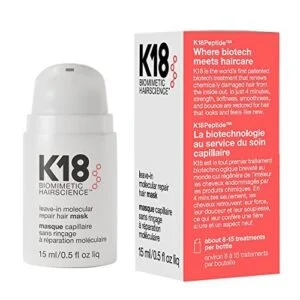This site is supported by our readers. We may earn a commission, at no cost to you, if you purchase through links.
You run a flat iron through your hair, and there they are—those telltale white dots at the ends that signal damage has set in. Split ends are one of the most frustrating hair problems because once the protective cuticle breaks down, that single strand literally fractures into two or more pieces.
The damage doesn’t stop there, either. Left untreated, splits travel up the hair shaft like a run in stockings, turning a small problem into a major one.
While you can’t magically fuse split ends back together, you can repair the damage, prevent it from worsening, and keep new splits from forming. The right combination of trimming, conditioning treatments, and protective techniques will restore your hair’s strength and give you healthier, smoother strands.
Table Of Contents
Key Takeaways
- Split ends happen when heat over 350°F, chemical treatments, rough brushing, and environmental stress break down your hair’s protective cuticle layer—but you can stop the damage from climbing higher by trimming every 6-8 weeks and using deep conditioning masks weekly.
- No product can fuse split ends back together, so cutting above the visible split is the only real fix, while leave-in conditioners, nourishing oils like coconut or castor, and bond-repair treatments can temporarily seal and strengthen damaged strands to prevent new splits.
- Switching to wide-tooth combs and microfiber towels cuts breakage by up to 50%, and keeping styling tools below 300-350°F with heat protectants reduces cuticle damage that leads to splitting.
- Prevention comes down to moisturizing routines tailored to your hair type, limiting heat styling to occasional use, protecting your hair from UV and harsh weather with hats or leave-ins, and scheduling regular trims to remove damage before it travels up the shaft.
What Causes Split Ends and Hair Damage
Split ends don’t just happen overnight. They’re the result of daily habits and environmental factors that gradually weaken your hair’s protective outer layer.
Let’s break down the main culprits so you know exactly what’s causing the damage.
Heat Styling and Chemical Treatments
Regarding split ends, heat styling and chemical treatments are two major culprits. Applying heat above 350°F strips moisture from your hair, while relaxers and bleach disrupt the cuticle layer, causing protein loss and structural weakness. Both compromise your hair’s protective barrier and set the stage for serious damage. A key way to maintain hair health is to use deep conditioning treatments to help restore moisture.
- Heat damage threshold: Excessive temperatures crack cuticles, making split ends inevitable
- Chemical treatment risks: Relaxers and dyes strip hydrophobic lipids, weakening hair bonds
- Cuticle layer impact: Repeated exposure causes detachment and increased porosity
Safe styling practices and protein loss prevention start with understanding these risks. If you’re not using heat protectants or spacing out chemical treatments, you’re inviting breakage. Preventing split ends means respecting your hair’s limits and prioritizing its health over every styling trend.
Mechanical Stress and Over-Brushing
Heat isn’t the only troublemaker. Brushing your hair too hard or tugging through wet tangles stretches strands past their elasticity limits, causing hair breakage and damage. Over 40% of women admit to brushing habits that worsen split ends. Tool quality matters—cheap brushes and aggressive detangling increase cuticle fractures considerably. It’s worth remembering that many women risk long-term hair damage by using the wrong hairbrush.
| Brushing Mistake | What Happens | Better Approach |
|---|---|---|
| Brushing wet hair | Stretches fibers beyond recovery | Use a detangling brush gently |
| Forcing through knots | Creates microfractures at stress points | Work from ends upward slowly |
| Wrong brush type | Increases friction and cuticle lifting | Choose smooth, rounded bristles |
| Daily aggressive brushing | Displaces cuticle cells permanently | Brush only when necessary |
Knot prevention starts with gentleness and smarter brushing techniques.
Environmental Exposure and Dehydration
Brushing damage is only one piece of the puzzle. UV radiation breaks down hair proteins, while pollution creates cuticle fissures that trap moisture loss.
Combined aggressors like humidity and environmental damage work together, creating hair dryness that’s twice as destructive as single stressors alone.
Severe weather can strip 18% of hair moisture, leaving strands brittle and vulnerable to splitting—protection becomes non-negotiable for hair hydration.
Step-by-Step Guide to Repair Split Ends
Here’s the truth: once your hair splits, there’s no magical way to fuse it back together. But you can protect what’s left, stop the damage from climbing higher, and make your hair look healthier overall.
Once hair splits, no product can fuse it back—but you can protect what’s left and stop damage from climbing higher
The following steps will show you exactly how to manage split ends and keep your hair in better shape moving forward.
Trim Split Ends Regularly
Here’s the truth: once a split end forms, no product can truly repair it—only sharp scissors can. Cutting above the visible split, ideally every 6–8 weeks, stops damage from traveling up the shaft and preserves your hard-earned length.
- Use professional-grade shears to prevent fraying
- Trim 1–2 millimeters above each split
- Schedule cuts every 4–6 weeks for heat-styled hair
- Try “dusting” to maintain length while removing damage
Deep Conditioning and Hair Masks
Deep conditioning treatments are your next line of defense after trimming. Weekly regimens reduce breakage by up to 61% in damaged hair, while clinical outcomes show a 24% reduction in visible split ends after just four weeks. Hair masks packed with keratin and argan oil rebuild protein structures and boost elasticity.
Here’s how to get the most from hair mask benefits:
| Application Protocols | Best Practice |
|---|---|
| Frequency | Weekly for damaged hair |
| Duration | 20–45 minutes on damp, clean hair |
| Enhancement | Use a warm towel to boost ingredient absorption |
| Post-Treatment | Gently towel-dry with a microfiber fabric |
Product performance matters—keratin- and peptide-rich formulas outperform standard conditioners in split end reduction, with user satisfaction rates above 75% after one month.
Using Leave-in Conditioners and Serums
After deep conditioning, layer on leave-in conditioner or hair serum to seal split ends and lock in hydration defense. Application practices matter—focus mid-lengths to ends where damage clusters.
Product selection for split end treatment should target breakage improvement and cuticle sealing with silicones or conditioning polymers. These formulas coat frayed fibers, reducing friction and making splits less visible while protecting against daily hair repair challenges.
Applying Nourishing Oils and Butters
Once leave-ins have worked their magic, natural oils and hair butters offer another layer of hair nourishment. Oil penetration matters—coconut reduces protein loss by 39%, while castor oil improves elasticity through hydration and repair properties.
Application methods boost hair oil benefits:
- Apply oils on damp hair for better absorption
- Blend lighter oils with heavier ones for enhanced butter hydration
- Focus treatment from mid-shaft downward where splits concentrate
- Layer regularly for protective benefits against environmental damage
These natural oils deliver hair moisturizing support while strengthening cuticles.
Gentle Handling and Protective Styling
Think of your daily hair routine as either medicine or damage—how you handle strands determines which direction you go.
| Technique | Benefit | Result |
|---|---|---|
| Wide combs on wet haircare | Reduces stress on elastic strands | 38% fewer breaks |
| Silk bonnets overnight | Cuts friction during sleep | 43% less damage |
| Low-manipulation styles with style breaks | Prevents chronic tension | 26% improvement over tight styling |
These hair care tips for split end prevention turn protective styling into your best defense against hair breakage and hair styling damage.
Top 5 Products for Split End Repair
You’ve trimmed the damage and learned the repair steps—now it’s time to pick the right products to back up your efforts. The market is packed with treatments claiming to fix split ends, but not all of them deliver real results.
Here are five standout products that actually work to strengthen damaged hair and prevent future splitting.
1. Not Your Mother’s Bonding Treatment
If you’re battling stubborn hair damage, Not Your Mother’s Bonding Treatment offers clinically backed bond repair that reduces breakage by 56% after a single use. This pre-wash hair treatment uses Active Bonding Technology with key ingredients like Bis-4-PCA Dimethicone and amino acids to rebuild broken hair bonds from chemical processing and heat styling.
Consumer feedback highlights noticeable improvements in smoothness within two weeks, while the product’s market impact—generating $10-15 million in first-year sales—speaks to its effectiveness.
Follow the usage protocol by applying weekly before shampooing for best split ends repair.
Best For: Anyone with damaged, chemically treated, or heat-styled hair looking for a drugstore bond repair treatment that delivers noticeable results without breaking the bank.
- Clinically proven to reduce breakage by 56% after just one use, with users reporting smoother, stronger hair within two weeks
- Vegan, sulfate-free, and paraben-free formula that meets clean beauty standards while still delivering professional-level bond repair
- Affordable price point in the drugstore segment makes advanced bond-building technology accessible compared to salon-exclusive alternatives
- May feel too heavy or greasy for fine or thin hair types if you use too much product
- Requires weekly pre-wash planning and extra time in your routine since it’s applied before shampooing
- Some users report it doesn’t provide enough slip for very coarse or curly hair during detangling
2. Regenerating Mask With Prickly Pear Oil
When your hair craves serious hydration and repair, this luxurious hair mask delivers with 60–70% linoleic acid from cold-pressed prickly pear seed oil.
The intensive hair treatment smooths cuticles and visibly improves split ends after just one use, targeting dry, damaged strands with antioxidant-rich vitamin E and essential fatty acids.
Apply weekly after shampooing—focus on mid-lengths to ends, leave for several minutes, then rinse.
Though pricey at $50.40, the concentrated formula means you’ll use less per application, making it a worthwhile investment for color-treated or chemically processed hair.
Best For: People with dry, damaged, or color-treated hair who want an intensive weekly treatment to reduce frizz, smooth split ends, and restore shine.
- Packed with antioxidant-rich prickly pear seed oil (60–70% linoleic acid) that deeply nourishes and protects hair from environmental damage
- Concentrated formula means you only need a small amount per use, and it visibly improves split ends and smoothness after one application
- Vegan, cruelty-free, and 97% natural-origin ingredients—safe for color-treated hair without silicones or parabens
- Expensive at $50.40, which might be a stretch for anyone on a tighter budget
- Some users report an unpleasant baby powder–like scent and mixed results on hydration
- Packaging issues (missing seals) and possible formula changes since the brand was acquired have raised concerns about quality and effectiveness
3. Davines Nounou Nourishing Hair Repair Mask
Davines Nounou Nourishing Hair Repair Mask delivers deep conditioning for chemically treated hair with a blend of jojoba oil, olive oil, and tomato extract. At $44 for 8.87 oz, this cream hair treatment targets damaged hair without weighing it down.
Apply to towel-dried hair for 10–15 minutes, focusing on mid-lengths and ends where split ends form. Cationic surfactants improve combability while vitamin E protects against oxidative stress.
User experiences consistently highlight improved softness and manageability—especially on bleached or color-treated hair that’s prone to dryness and breakage.
Best For: Anyone with bleached, color-treated, or chemically processed hair looking to restore moisture and softness without heavy buildup.
- Lightweight formula absorbs quickly and doesn’t weigh down fine or damaged hair
- Natural oils like jojoba and olive penetrate deeply to improve texture and reduce visible split ends
- Works fast—just 10-15 minutes to see noticeable softness and easier detangling
- At $44 for under 9 oz, it’s pricier than many drugstore alternatives
- Contains artificial dyes that might be a dealbreaker if you prefer fully clean formulations
- Results depend heavily on your specific hair type and damage level, so it won’t work miracles for everyone
4. K18 Leave In Molecular Hair Mask
K18 Leave In Molecular Hair Mask stands out with its patented K18 Peptide Technology, targeting split ends at a molecular level in just 4 minutes. This $75 treatment restores up to 91% of hair’s original strength and 94% of elasticity, according to clinical repair efficacy data from the manufacturer.
Consumer satisfaction is high among those with bleached or heat-damaged hair—you’ll notice softer, sealed ends after consistent application. Guidelines recommend four consecutive washes.
Safety limitations include limited independent peer review, though the formula remains vegan and cruelty-free for damaged hair treatment.
Best For: People with bleached, color-treated, or heat-damaged hair who want fast molecular repair and are willing to invest in a premium treatment.
- Restores up to 91% of hair strength and 94% of elasticity in just 4 minutes, with noticeable results after a few uses
- Works on all hair types and requires only a small amount per application, making the bottle last longer than expected
- Vegan, cruelty-free, and free of silicones and parabens, so it’s a clean option for damaged hair
- Expensive at $75 for a 1-ounce bottle, which raises value concerns for some buyers
- Effectiveness varies—some users report it doesn’t moisturize or work well for their specific hair type
- Lacks independent peer-reviewed studies beyond manufacturer clinical data, so long-term proof is limited
5. Redken Extreme Anti Breakage Treatment
Redken Extreme Anti Breakage Treatment offers a different approach—strengthening hair from within to prevent split ends before they start. This leave-in formula uses amino acids and arginine to reduce hair breakage by up to 75% when paired with the full system, according to clinical data.
You’ll apply it to damp hair after washing, focusing on fragile areas. The treatment provides 5-in-1 stressor protection against heat, chemicals, and mechanical damage.
Its safety profile is solid, with transparent ingredient disclosure and no major adverse reactions reported in consumer studies.
Best For: Anyone dealing with damaged, fragile hair who wants a salon-quality treatment that strengthens strands and reduces breakage without the hassle of rinsing.
- Clinically proven to reduce breakage by up to 75% when used with the full system, with visible improvements in strength and shine
- Lightweight leave-in formula works as a daily treatment and detangler, protecting against heat, chemicals, and mechanical damage
- Transparent ingredient list with a solid safety profile and no major adverse reactions reported
- Price point runs higher than drugstore alternatives, which may be a stretch for budget-conscious buyers
- Works best as part of the complete Extreme system rather than as a standalone product
- Some users report it’s not quite as effective as premium salon brands despite the professional-grade claims
How to Prevent Split Ends in The Future
Once you’ve tackled existing split ends, the real challenge is keeping them from coming back. Prevention comes down to changing a few daily habits and being more mindful about how you treat your hair.
Let’s walk through the most effective strategies to keep your ends healthy and intact.
Limit Heat Styling and Use Heat Protectants
One of the biggest culprits behind split ends is heat styling. If you’re reaching for your flat iron or blow-dryer daily, you’re exposing your hair to temperatures that can crack cuticles and weaken strands. Here’s how to protect your hair from heat damage:
- Use heat protectants with silicone or polymer ingredients to create a protective barrier
- Keep styling tools below 300°F for fine hair, 350°F for normal textures
- Apply heat protection spray before every styling session to reduce moisture loss
- Limit passes with flat irons—one or two per section maximum
- Reserve high-heat tools for occasional use rather than daily styling routines
Temperature thresholds matter more than you think. Research shows that blow-drying techniques using moderate heat preserve cuticle structure better than extreme temperatures. When you do style, move your dryer constantly and maintain distance from your hair to avoid hot spots that accelerate splitting.
The impact of styling tools adds up over time. Even with heat protection, frequent exposure weakens bonds in your hair’s keratin structure. By limiting heat frequency and choosing lower settings, you’ll notice fewer split ends and stronger, healthier hair overall.
Adopt Moisturizing Hair Care Routines
Beyond heat control, moisture is what keeps your strands resilient. About 80% of women already follow structured hair care routines that prioritize hydration—and for good reason. Moisturizing regimens reduce visible split ends by 30% over 12 weeks, strengthening hair structure and improving manageability.
Hydration Frequency and Routine Benefits
| Hair Type | Recommended Routine |
|---|---|
| Dry or color-treated | Deep conditioning masks 2–3 times weekly |
| Curly or textured | Shampoo every 10–14 days; moisturize every 2–3 days |
| Fine or oily | Intense treatments once weekly to avoid build-up |
Choose products with natural oils like jojoba or avocado, avoiding sulfates and parabens. Hydrating shampoos improve elasticity, while leave-in conditioners lock in moisture for hours.
Consumer trends show a shift toward plant-based formulations that support long-term hair repair and dehydration resistance. The payoff? Smoother texture, reduced frizz, and greater shine—all measurable improvements that protect against future splitting.
Use Wide-Tooth Combs and Microfiber Towels
Your tools matter as much as your products. Switching to a wide-tooth comb and microfiber towel cuts hair breakage by up to 50% when used together—proof that smart detangling protects against split ends and damage before they start.
5 Ways These Tools Protect Your Hair:
- Comb breakage reduction: Wide-tooth combs lower breakage rates by 35%, especially on chemically treated strands
- Towel friction reduction: Microfiber towels create 40% less friction than cotton, reducing frizz and cuticle lifting
- Gentle wet detangling: Less mechanical tension means fewer tangles and lower shedding during your routine
- Curl pattern maintenance: Wide-tooth spacing preserves natural curl definition without disrupting your texture
- Hair health integration: Combined use improves smoothness, cuts grooming time, and strengthens resilience over eight weeks
Schedule Regular Haircuts
Consistent trims every 6–8 weeks stop split ends from traveling up your hair shaft, boosting length retention and texture improvement while reducing frizz by up to 80%. Regular trims don’t speed growth, but they preserve what you’ve gained by cutting hair damage before it breaks.
This proactive approach to hair care keeps your strands manageable, healthier-looking, and primed for preventing split ends long-term.
Protect Hair From Harsh Weather and UV Exposure
Think of sun and cold as silent culprits of hair shaft damage—UV hair damage strips cuticles while weather-related damage dehydrates strands. Product UV efficacy falls short, so lean on protective accessories like wide-brimmed hats for integrated protection.
Pair them with leave-in conditioners to shield against environmental damage. This layered hair care approach minimizes hair protection gaps and keeps your lengths strong.
Frequently Asked Questions (FAQs)
Can split ends affect hair growth rate?
Split ends are like frayed rope—they don’t stop hair growth at your roots, but breakage creates a perceived growth stunt.
Your follicles keep producing new hair at 5 inches monthly, regardless of damage.
Do split ends differ by hair type?
Yes, curly hair and coarse textures show higher split end rates due to dryness and structural differences. Ethnic variations in hair porosity and damage factors mean certain hair types need more intensive split end treatment and repair.
Are there professional salon treatments for split ends?
Hair salons offer bond-building treatments like Olaplex, protein reconstructive masks, and keratin smoothing services that temporarily seal and strengthen damaged strands—though trimming remains the only permanent split end solution.
Can diet or nutrition help prevent split ends?
Your diet absolutely matters. Essential nutrients like protein, vitamins, and minerals strengthen hair follicles and improve hair health.
Staying hydrated, eating beneficial foods rich in iron and biotin, plus targeted nutrition interventions measurably reduce breakage.
How do you identify split ends early?
Like finding the first crack in a mirror, you can catch split ends early by checking for “Y” shapes at tips, feeling for rough texture, and noticing increased tangles—signs of hair damage before it spreads.
Conclusion
Even if your ends look damaged beyond saving, you don’t have to resign yourself to brittle, frayed hair. Learning how to repair split ends means taking consistent action—trimming regularly, conditioning deeply, and handling your strands with care.
The techniques and products you’ve explored here will stop damage in its tracks and restore your hair’s natural strength. Healthier hair isn’t out of reach. It’s just a few intentional steps away.
- https://ellatu.com/blogs/news/what-hair-is-more-prone-to-split-ends
- https://www.reddit.com/r/HaircareScience/comments/v1sfqe/everyone_always_says_to_cut_off_split_ends_or/
- https://www.crodabeauty.com/en-gb/resources/blog/the-science-of-split-end-repair-sem-studies-on-crodabond-csn
- https://www.trinitisalon.com/treatments-pricing/
- https://www.shazandkiks.com/blogs/read/the-best-ingredients-for-split-ends

